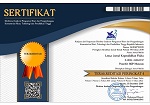Integrated Science Learning with Connected Model Based on Ethnoscience to Enhance the Creative Thinking Dimension of Pancasila Student Profile
DOI:
https://doi.org/10.33394/j-lkf.v12i2.14441Keywords:
Connected, Creative thinking, Ethnoscience, Integrated science, Pancasila student profileAbstract
This study aims to analyze the effectiveness of integrated science learning using a connected model based on ethnoscience to improve the Pancasila Student Profile, particularly in the creative thinking dimension. A quantitative approach with a quasi-experimental method was employed. The research sample consisted of 30 eighth-grade students from MTs Ma'arif Garung, divided into experimental and control groups. Research instruments included pretests, posttests, observation sheets, and interviews. Data analysis was conducted using t-tests and N-Gain analysis with SPSS software. Results indicated that the average N-Gain score for the experimental class reached 60%, categorized as effective, while the control class scored 42.3%. The t-test yielded a significance value of 0.000 (<0.05) and a t-value of 3.846 (>t-table 2.074), indicating that the ethnoscience-based connected learning model effectively enhanced students' creative thinking skills.
References
Darwanto, D. (2019). Kemampuan Berpikir Kreatif Matematis: (Pengertian dan Indikatornya). Eksponen, 9(2), 20–26.
Dauli, N. (2019). Metodologi Penelitian Kuantitatif. Yogyakarta: CV Budi Utama.
Fogarty, R. (1991). The Mindful School: How to Integrate the Curricula. Illinois: Skylight Publishing.
Goran, M. B., Kaleka, M. B. U., & Daud, M. H. (2021). Profil Kemampuan Berpikir Kreatif Fisika Siswa Kelas X SMA Negri 1 Demon Pagon Flores Timur. Jurnal Pendidikan Fisika, 5(6), 113-121.
Idrus, S. W. Al. (2022). Implementasi STEM Terintegrasi Etnosains (Etno-STEM) di Indonesia: Tinjauan Meta Analisis. Jurnal Ilmiah Profesi Pendidikan, 7(4), 2370–2376. https://doi.org/10.29303/jipp.v7i4.879
Mardiyah H. R., Aldriyani, C. & Zulfikar R. M., (2021). Pentingnya Keterampilan Belajar di Abad 21 sebagai Tuntutan dalam Pengembangan Sumber Daya Manusia. Jectura: Jurnal Pendidikan, 71(1), 63–71.
Nurhasnah, N., Azhar, M., Yohandri, N., & Arsih, F. (2022). Etno-Stem Dalam Pembelajaran Ipa : a Systematic Literature Review. Kwangsan: Jurnal Teknologi Pendidikan, 10(2), 147. https://doi.org/10.31800/jtp.kw.v10n2.p147--163
Rifka, A, d. (2022). Metode Penelitian Kuantitatif&Kualitatif. Makassar: Tohar Media.
Saputri, V., & Herman, T. (2022). Integrasi STEM Dalam Pembelajaran Matematika: Dampak Terhadap Kompetensi Matematika Abad 21. Journal Pembelajaran Matematika Inovatif, 5(1), 247–260. https://doi.org/10.22460/jpmi.v5i1.247-260
Sriwijaya, U. (2023). Implementasi Kebhinekatunggalikaan Dan Sila-Sila Pancasila Sebagai Penguatan Profil Pelajar Pancasila Kurnia Widiyani. Jurnal Pendidikan West Science, 1(02), 150–158.
Sunaryati, T., Subekti, W. U., Lukito, A. N., & Sari, W. P. (2024). Analisis Pengembangan Pembelajaran Terpadu Berbasis Kearifan Lokal Guna Meningkatkan Daya Kognitif Dan Perkembangan Karakter Siswa Di Sekolah Dasar. Jurnal Ilmu Pendidikan Dan Pembelajaran, 06(4), 158–184.
Susilawati, E., Sarifudin, S., & Muslim, S. (2021). Internalisasi Nilai Pancasila Dalam Pembelajaran Melalui Penerapan Profil Pelajar Pancasila Berbantuan Platform Merdeka Mengajar. Jurnal Teknodik, 25, 155–167. https://doi.org/10.32550/teknodik.v25i2.897
Usmadi, U. (2020). Pengujian Persyaratan Analisis (Uji Homogenitas dan Uji Normalitas). Jurnal Inovasi Pendidikan, 7(1), 50-62.
Downloads
Published
How to Cite
Issue
Section
License
Authors who publish with Lensa: Jurnal Kependidikan Fisika agree to the following terms:
- For all articles published in Lensa: Jurnal Kependidikan Fisika, copyright is retained by the authors. Authors give permission to the publisher to announce the work with conditions. When the manuscript is accepted for publication, the authors agree to automatic transfer of the publishing right to the publisher.
- Authors retain copyright and grant the journal right of first publication with the work simultaneously licensed under a Creative Commons Attribution-ShareAlike 4.0 International License that allows others to share the work with an acknowledgment of the work's authorship and initial publication in this journal.
- Authors are able to enter into separate, additional contractual arrangements for the non-exclusive distribution of the journal's published version of the work (e.g., post it to an institutional repository or publish it in a book), with an acknowledgment of its initial publication in this journal.
- Authors are permitted and encouraged to post their work online (e.g., in institutional repositories or on their website) prior to and during the submission process, as it can lead to productive exchanges, as well as earlier and greater citation of published work (See The Effect of Open Access).

This work is licensed under a Creative Commons Attribution-ShareAlike 4.0 International License.



